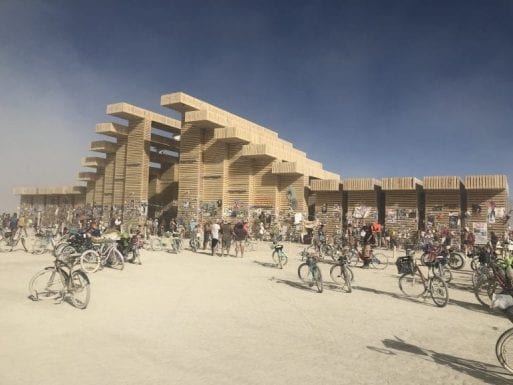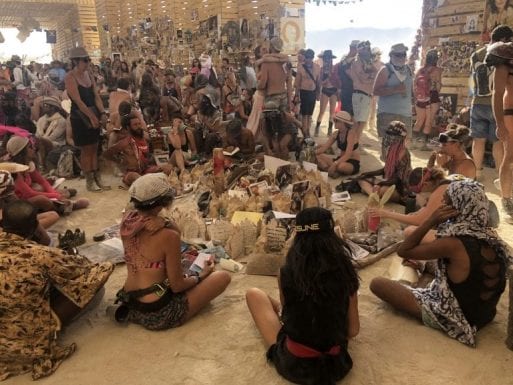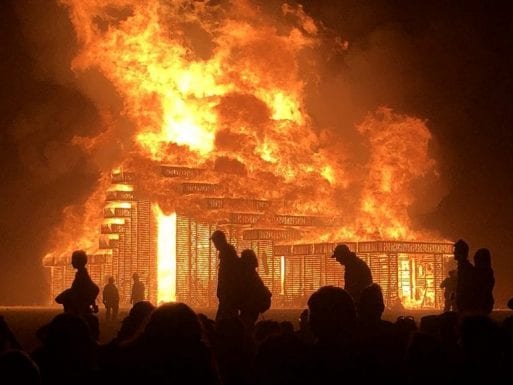Black Rock City
Black Rock City exists for just a few short weeks every year before it’s torn down and all evidence of its presence on a dusty lake bed called the Playa is erased. It’s constructed anew each August for Burning Man — the 9-day community and arts event that draws 70,000 participants from around the world to the desert of Northwest Nevada. Black Rock City is a unique place, where it’s matter of course to see a topless woman in a utility kilt and motorcycle goggles ride by on a dragon shooting flames out of its nostrils, or someone wearing a unicorn gas mask climbing inside a 40-foot-tall glowing jellyfish covered in thousands of LED lights, or a hundred people dressed as bunnies march by “protesting humanity.” But Black Rock City also has the typical hallmarks of any other city: emergency, safety, and sanitary infrastructure, a DPW, an airport, law enforcement headquarters, and a plan that lays out streets, plazas, and hundreds of waystations. It also has a place of worship, though it’s not linked to any cohesive set of spiritual beliefs. Citizens of Black Rock City — also known as “burners” — call it, simply, the Temple.
The Tradition of the Temple
The widespread perception of Burning Man is that it’s an irreverent bacchanalia, and in many ways, it is. But there’s a physical space there that functions as a repository of grief, and it’s a major part of the event. Artists David Best and Jack Haye brought the first Temple, The Temple of the Mind, to Burning Man in 2000. When a friend and member of their Temple build crew died in a motorcycle accident shortly before the event, the Temple of the Mind became a memorial to him. Burners began to write the names of people they’d lost on the structure, and by the end of the week, thousands of names covered its walls. Best was struck by the need burners had for a place to grieve. Every year since, Burning Man has featured a Temple — each with a distinct design and name.
The Temple of Direction
San Francisco-based architect and eight-time Burner Geordie Van Der Bosh designed this year’s Temple, which he called the Temple of Direction. He designed the linear, 80-foot-long, 37-foot-wide, 36-foot-high structure to reflect the passage through life, with its beginning, middle and end. It included an altar in the middle and lanterns decorating its interior and exterior. “I was trying to create a sense of shared experience,” Van Der Bosh tells me. Since this temple was linear, everybody had to walk along the same path inside it. Everyone saw the same things as they walked through the temple in the same direction. And that’s, of course, where it got its name — The Temple of Direction.”
Van Der Bosh headed up a crew of 50 volunteers who spent two-and-a-half weeks before the event physically constructing the Temple of Direction. “There was a great sense of accomplishment in building it with them and hearing all of their personal motivations for being there,” the architect said.
Spirituality and the Temple
The Black Rock City census for 2018 reported that 46.6 percent of burners that year identified as “spiritual, but not religious.” Twenty-three percent identified as atheist; 15.7 percent identified as agnostic; 8.4 percent identified as “I don’t know;” 5.4 identified as religious, and 0.7 identified as deist. If you are “spiritual but not religious,” where do you go to publicly and communally grieve? There aren’t many other cities with non-denominational sacred buildings for the generally spiritual-but-not-religious to gather and make private grief a collective experience. And so, spending time and leaving tributes at the Temple has become a core piece of how many burners process loss.
Over the past 20 years that Jaye Hersh has attended Burning Man, she’s suffered the losses of both of her parents, her beloved dog, and several friends who died by suicide. “It feels like almost every year there’s somebody for me to grieve. I’m not religious, so I don’t have a church, for example, to grieve my losses. The Temple provides that space for me. Each year, whenever I get within 150 yards of the Temple, I can feel the energy of the thing, and it’s profound.”
Memorials
Memorials line the Temple by the end of the event week. It is not only deaths that burners grieve at the Temple. Some leave memorials to marriages that have ended or notes to themselves with the intention of releasing old habits and wounds. People write directly on the Temple walls, leave photographs, shoes, jewelry, copies of wills — all manner of remembrances. Historically, burners have also frequently left cremated remains at the Temple, though the Pyramid Lake Paiute Tribe, whose reservation is adjacent to the Black Rock Desert, have requested the termination of this practice. The Paiute believe that human remains negatively affect the living spirits present within the Playa and surrounding areas under the Tribe’s protection. Dean Barlese, spiritual leader of the Tribe, says, aside from cremated remains, “Anything else to bring about healing for individuals is okay in our view.”
Throughout the week, day and night, there are always people gathered at the Temple: sitting in silence, singing quietly, crying, holding each other, or deep in hushed conversation. “You’re blowing out your senses while you’re at Burning man,” says Bobby Wong, who has attended Burning Man four times. “There’s a lot of visual stimulation, a lot of sound, you’re dealing with the dust and the heat. The Temple is a calm place where you can go and allow yourself to feel any and everything you might be working through,” Wong says. “The Temple was the place I went to process the feelings I was still carrying from the losses of my mother and grandmother. Grieving there, meditating there, leaving a letter there, was something I really needed at the time.”
Natalie Martins lost her best friend to cancer in 2015. That year, she brought the roses from his funeral to Black Rock City and left them at the Temple. “I think the experience in the Temple allows us to not feel so isolated when we are in such deep pain,” she says.
Temple Guardians
A group of volunteers known as Temple Guardians stand watch over the Temples each year. They work in 4-hour shifts and are present at the structure 24 hours a day. Steve Cabrera, who serves as the leader of the Temple Guardians, tells me the role of the Temple Guardian is “to hold the space of the Temple and to keep it safe.” He explains: “We define creating and holding space as witnessing what is happening without adding anything to it — especially our own interpretations about what’s good or bad, what’s appropriate or not, what’s spiritual or not.” Temple Guardians pick up MOOP (a Burning Man acronym for Matter Out of Place, or litter), chase and secure offerings that the wind blows away, and make sure visitors don’t climb on the structure or light flames inside.
Krsna Chandra, who volunteered as a Temple Guardian this year, found herself overwhelmed during her first shift, reading the offerings on the walls with the thousands of expressions of grief chronicled there. “I did a fair bit of crying under my goggles and bandana,” she says. More experienced Temple Guardians advised her, sharing their own experiences, reminding her to ground. “By the second half of my shift, I was able to feel the power of the Temple without being overcome by the emotion there.”
“Such incredible angels, Temple Guardians are,” says Tish Sloane. In 2007, Sloane’s crew lost a friend to suicide. They rode their bicycles to the Temple together, wrote messages to their friend on the walls, left photographs, shared memories, and cried. Sloane remembers a Temple Guardian approaching as she tearfully walked away: “He asked if I wanted a hug. I said yes and he held me while I wept. He told me he had lost his son a long time ago and that’s why he volunteered as a Temple Guardian. He told me that sometimes our closest people have to go first so that they’ll be there to help us when we get there.”
Ritual at the Temple
Though the only official Temple ritual happens at the end of the event, when the structure is burned, there are many unofficial rituals that take place throughout the week. This year, pastors from a theme camp called Religious As Fuck held a Christian memorial service at the Temple. Patty Jenkins, one of the pastors who led the service, delivered a sermon to attendees, offered communion, and set aside time for anyone in attendance to publicly share, if there was something or someone that they were grieving. “When we have no one to witness our grief it remains ragged. When there is no one to bind our wounds, healing comes slowly or not at all. The truth is we cannot heal ourselves. We need each other to heal,” Jenkins told the gathered crowd, who shared stories of losing parents, partners, children, and friends.
Jared Alexander Ross happened upon the service on Friday and stopped to join. Ross had come to the Temple to grieve the loss of a friend who died of a drugs overdose. “The service was beautiful,” he says. “It was verifiably Christian in nature, but it recognized that and was poignantly inclusive of all the spiritual diversity on the Playa, including those who may have been wronged by Christianity in the past. They really did a masterful job of weaving Christ into the principles of Burning Man and into the nature of the event (arguably a hotbed of ‘sin!’) and it was just brilliant. One of the highlights of my week, and something I will always carry with me.”
The Temple Burn
Burning Man always ends on a Monday. The eponymous Man — an enormous wooden effigy newly constructed each year — is burned to the ground on the preceding Saturday night, with a spectacular display of fireworks and the whole city out celebrating. The Temple goes up in flames on Sunday at sunset, and it has become closing ceremony for the event. Temple Guardians, along with the Black Rock City Rangers (Burning Man’s volunteer first-response team) hold the safety perimeter around the structure. Behind them, closer to the structure, are the Sandmen — a sub-group of rangers who constitute the last line of defense between attendees and the fire. They are trained to tackle anyone who might attempt to run into the fire, and to keep the crowd at bay if it starts to surge forward. Professional firefighters join the the Sandmen in holding the inner perimeter. Sandmen don’t watch the burn: they keep their backs to the fire. The Burn Perimeter Briefing document reminds Sandmen: “Fire is pretty. Don’t look at the fire; look at your crowd. Honestly, after you have seen a few burns, the sense of wonder and joy on the crowd’s face is far more interesting.”
The mood of the Temple burn is reverent, contemplative. Burners sit in silence watching, occasionally calling out the names of their dead. The word catharsis comes up over and over, when burners speak of the Temple burn. There is great catharsis in seeing one giant fire consume the physical manifestations of one’s grief, along with the grief of thousands of others who are also sitting there, quietly watching, quietly crying, quietly asking the fire to help them let go.
“Temple Burn is probably my favorite part of the week, even though I’m usually weeping,” says Jaye Hersh. “Everyone is so silent that you can actually hear the sounds of the Temple burning. Watching the Temple go up in flames, along with tributes I’ve left to the people I’ve loved who have died, feels like a release. When somebody has passed away — particularly if they’ve taken their own life, as a number of my close friends have — it’s hard to feel a sense of closure. I’ve often not known how much a friend was suffering until it was too late. The Temple gives me an opportunity to find that closure.”
Impermanence
Burning Man is a concentrated lesson in impermanence. Artists pour time, money, heart, and sweat into creating mammoth art installations that only exist for the event. Attendees build theme camps they spend all year planning, only to tear them down nine days after they’re built. Members of Black Rock City’s DPW clock thousands of hours of grueling labor building and then deconstructing the core infrastructure of the city. And, just like that, Black Rock City returns to the dust. The Temple, a place where burners have mourned and meditated and wept, becomes ash before their eyes. The Temple, from its construction through its burn, provides on opportunity to reflect on the impermanence of the material objects we hold dear, the impermanence of life itself, and the impermanence of grief’s iron grip once we begin to heal.

 Grieving at The Temple at Burning Man
Grieving at The Temple at Burning Man





 John Mulaney’s “Funeral Planning” on Netflix: No Real Plan
John Mulaney’s “Funeral Planning” on Netflix: No Real Plan

 Composting Bodies Is Now Legal in a Dozen States
Composting Bodies Is Now Legal in a Dozen States














